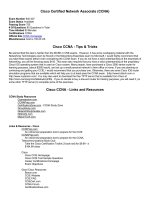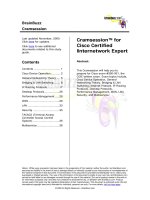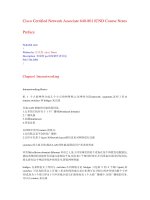Cisco Certified Network Associate (CCNA)
Bạn đang xem bản rút gọn của tài liệu. Xem và tải ngay bản đầy đủ của tài liệu tại đây (57.41 KB, 3 trang )
Cisco Certified Network Associate (CCNA)
Exam Number 640-407
Exam Status Available
Passing Score 755
# Of Questions 80 Questions In Total
Time Allotted 90 Minutes
Certifications CCNA
Official Site CCNA Homepage
Miscellaneous Cost is 100.00 US
Cisco CCNA - Tips & Tricks
Be warned that this test is harder than the MCSE or CNE exams. However, it has some overlapping material with the
Networking Technologies exam by Novell or the Networking Essentials exam by Microsoft. I would highly recommend that
you take these exams before even considering the CCNA exam. If you do not have a solid understanding of the essentials of
networking, you will be throwing away $100. This exam also requires that you have a solid understanding of the proprietary
Cisco IOS operating system that is used on Cisco routers. Many people, have purchased a Cisco 2500 series router for
learning purposes, (about $2000 each), and set up a small personal network in their office or home. If you are planning on
continuing and getting your CCIE, I would recommend that you purchase one. Otherwise, there are some Cisco IOS router
simulation programs that are available which will help you to at least pass the CCNA exam. ( or
You may also want to download the free TFTP server that is available from Cisco at
. If you do decide to buy a low-end router for training purposes, you will need it, (or
some other TFTP server) to complete some of the exercises.
Cisco CCNA - Links and Resources
CCNA Study Resources
Cramsession.com
CCNAPrep.com
CertificationZone.com - CCNA Study Zone
GroupStudy.com
NetworkStudyGuides.com
NetCerts.com
MasonTech.com
Links & Resources - Cisco
CCIEPrep.com
An online test preparation tool to prepare for the CCIE.
CCNAPrep.com
An online test preparation tool to prepare for the CCNA.
Telecommunications Book Club
Take the Cisco Certification Toolkit (3 book set) for $9.99 - a
$184.99 value
Cisco
Cisco CCIE Homepage
Cisco CCIE Test Sample Questions
Career Certifications Homepage
Exam Objectives
Good Cisco Resources
Boson.com
CCIE Website
CCIE FAQ
CCIECert.com
CCNA Forum
CertificationZone.com
CiscoCert.com
CiscoCertified.com
Cisco IOS Router Commands
Cisco Networking FAQ
Cisco Systems In A Nutshell
Dmitry's Technical Cisco Web Site
GroupStudy.com
The Joy Of CCIE
Keith's Cisco Reference Manual
Mentor Labs
NetCerts.com
NetworkStudyGuides.com
PC Age
VirtualRack.com
What to Know
OSI Reference
1) Identify and describe the functions of each of the seven layers of the OSI reference model.
2) Describe connection-oriented network service and connectionless network service, and identify the key
differences between them.
3) Describe data link addresses and network addresses, and identify the key differences between them.
4) Identify at least 3 reasons why the industry uses a layered model.
5) Define and explain the 5 conversion steps of data encapsulation.
6) Define flow control and describe the three basic methods used in networking.
7) List the key internetworking functions of the OSI Network layer and how they are performed in a router.
WAN Protocols
8) Differentiate between the following WAN services: Frame Relay, ISDN/LAPD, HDLC, & PPP.
9) Recognize key Frame Relay terms and features.
10) List commands to configure Frame Relay LMIs, maps, and subinterfaces.
11) List commands to monitor Frame Relay operation in the router.
12) Identify PPP operations to encapsulate WAN data on Cisco routers.
13) State a relevant use and context for ISDN networking.
14) Identify ISDN protocols, function groups, reference points, and channels.
15) Describe Cisco's implementation of ISDN BRI.
IOS
16) Log into a router in both user and privileged modes.
17) Use the context-sensitive help facility.
18) Use the command history and editing features.
19) Examine router elements (RAM, ROM, CDP, show).
20) Manage configuration files from the privileged exec mode.
21) Control router passwords, identification, and banner.
22) Identify the main Cisco IOS commands for router startup.
23) Enter an initial configuration using the setup command.
24) Copy and manipulate configuration files.
25) List the commands to load Cisco IOS software from: flash memory, a TFTP server, or ROM.
26) Prepare to backup, upgrade, and load a backup Cisco IOS software image.
27) Prepare the initial configuration of your router and enable IP.
Network Protocols
28) Monitor Novell IPX operation on the router.
29) Describe the two parts of network addressing, then identify the parts in specific protocol address examples.
30) Create the different classes of IP addresses [and subnetting].
31) Configure IP addresses.
32) Verify IP addresses.
33) List the required IPX address and encapsulation type.
34) Enable the Novell IPX protocol and configure interfaces.
35) Identify the functions of the TCP/IP transport-layer protocols.
36) Identify the functions of the TCP/IP network-layer protocols.
37) Identify the functions performed by ICMP.
38) Configure IPX access lists and SAP filters to control basic Novell traffic.
Routing
39) Add the RIP routing protocol to your configuration.
40) Add the IGRP routing protocol to your configuration.
41) Explain the services of separate and integrated multiprotocol routing.
42) List problems that each routing type encounters when dealing with topology changes and describe techniques to
reduce the number of these problems.
43) Describe the benefits of network segmentation with routers.
Network Security
44) Configure standard and extended access lists to filter IP traffic.
45) Monitor and verify selected access list operations on the router.
LAN Switching
46) Describe the advantages of LAN segmentation.
47) Describe LAN segmentation using bridges.
48) Describe LAN segmentation using routers.
49) Describe LAN segmentation using switches.
50) Name and describe two switching methods.
51) Describe full- and half-duplex Ethernet operation.
52) Describe network congestion problem in Ethernet networks.
53) Describe the benefits of network segmentation with bridges.
54) Describe the benefits of network segmentation with switches.
55) Describe the features and benefits of Fast Ethernet.
56) Describe the guidelines and distance limitations of Fast Ethernet.
57) Distinguish between cut-through and store-and-forward LAN switching.
58) Describe the operation of the Spanning Tree Protocol and its benefits.
59) Describe the benefits of virtual LANs.
60) Define and describe the function of a MAC address.









